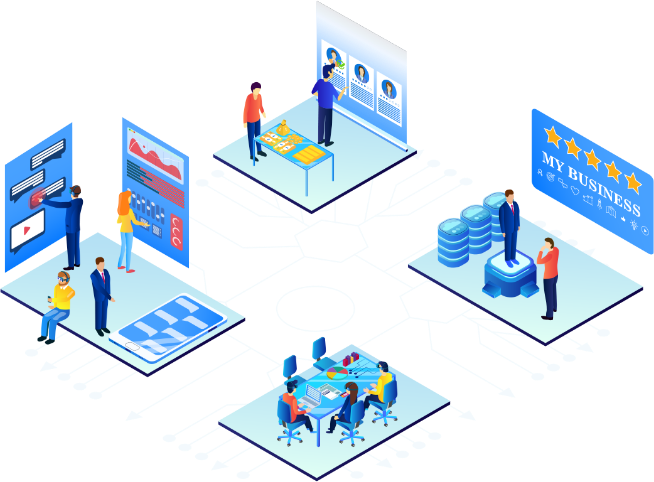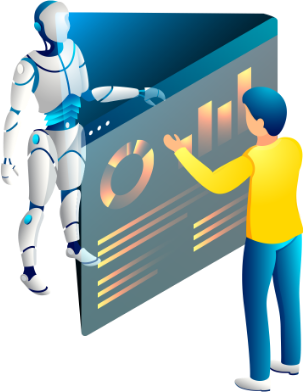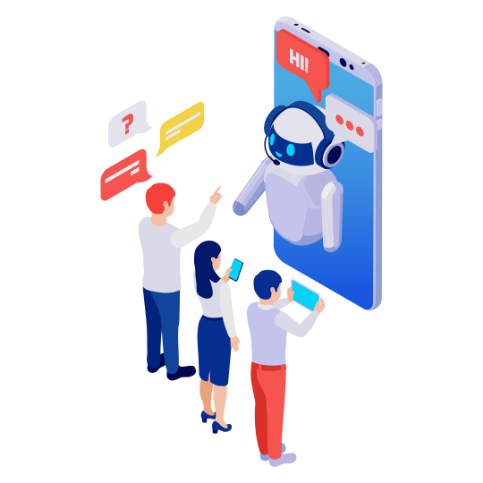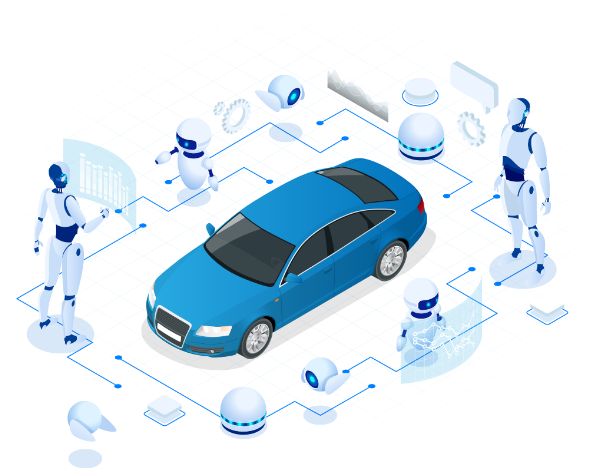What is AIOps
Here’s Everything You
Need to Know
![]()
Artificial Intelligence for
IT Operations (AIOps)

What is AIOps?
![]() Benefits of AIOps
Benefits of AIOps
![]() Digital Transformation with AIOps
Digital Transformation with AIOps
![]() Use Case
Use Case
![]() The Future of AIOps
The Future of AIOps
![]() How to Get Started?
How to Get Started?

Artificial Intelligence for IT Operations (AIOps)
AIOps has emerged as the ultimate solution to the challenge of rapid adoption of modern technologies and ever-increasing complexity in IT in recent times. ITOps deal with massive amounts of data, putting an enormous strain on the IT workforce.
Hiring more employees is neither cost-effective nor scalable. Furthermore, this results in a loss of optimization and real-time monitoring and resolution of issues. Traditional automation tools can assist in dealing with increased complexity, but it requires humans to configure, deploy, and manage them, limiting their ability to simplify increasingly complex IT environments.
AIOps handles these routine tasks like these efficiently to ease the burden on workforce and automates important functions such as monitoring, service desk, and technical support, among other solutions.


What is AIOps?
AIOps stands for Artificial Intelligence for IT Operations. Gartner coined the term – AIOps to explain how the application of big data analytics in the form of AI and ML was enabling new efficiencies for IT operations teams in the form of decision making and helping with data insights and analytics.
AIOps enables the automation of processes, including event correlation, anomaly detection, and causality determination, that would otherwise necessitate significant manual intervention by humans.
AIOps tools are used by businesses that deal with large amounts of data and need to process it for analytics and business insights. Businesses depend on AIOps Solutions to handle logs while analysing critical data using Artificial Intelligence and Machine Learning. As a result, AIOps Platforms have become a critical need for businesses, and particularly necessary for Digital Transformation and IT System Integration. To get the most out of the AIOps technology, the engineers must implement AIOps Best Practices like proper data management, data security, task hierarchy assignment, and proper use of available AI APIs.
Read this blog on What you need to know about AIOps


Benefits of AIOps
AIOps provide great visibility of the IT environment and provide operations teams with the speed and agility they need to detect incidents early and ensure the availability of critical services. AIOps benefits not only IT and cloud-based businesses, but also healthcare, finance, insurance, and several other industries. Following are the key benefits of AIOps:
Single Dashboard
With an integrated AIOps Platform, all application and infrastructure operations can be managed from a single dashboard. This makes it simple and easier to view and manage the data.
Reduction in Mean Time to Resolution (MTTR)
The best AIOps tools can identify root causes and propose solutions faster and more accurately than humans by cutting through IT operations noise and correlating operations data from multiple IT environments. AIOps-based platforms provide actionable insights to reduce the MTTR.
Reduce operational costs and downtime
Reduced complexity and time spent by an IT team on specific tasks can result in cost savings. AIOps reduce the number of alerts significantly, provide actionable insights about incidents, and automate workflows. This enables organizations to improve efficiency and incident management, as well as reduce the number of escalations and downtime. AIOps platforms software is useful in incident management scenarios because it provides the knowledge base of many specialists to a single operator.
More Observability
Observability provides us with metrics that allow us to truly understand the application, what’s going on inside a system, and how well it is performing. When it comes to AIOps vs Observability, although these two works in slightly different ways and serve different purposes, they are inextricably linked and should be used together to create a holistic incident management solution. Together, it provides businesses with improved visibility, communication, and transparency, which helps to make better decisions and address issues more quickly.
More proactive
With predictive analytics capabilities built-in, AIOps continuously learn to identify and prioritize the most critical alerts, allowing IT teams to address potential issues before they cause slowdowns or outages. The best AIOps software has the capability to self-learn, and no rules need to be configured manually.
Digital Transformation with AIOps
With the increased focus on digital transformation, AIOps is the future of IT operations. Hybrid and multi-cloud infrastructures are creating complexity day by day. Keeping up with customer demands and handling the complexity of IT infrastructure is difficult with traditional IT performance management processes. Therefore, AIOps become necessary.
AIOps products have the potential to transform and scale the enterprise. It can help achieve digital transformation goals such as improving customer outcomes, increasing revenue, lowering operational costs, and bringing operational resilience. AIOps solutions detect problems quickly and respond to alerts, tickets, and notifications faster. According to the GMI report, the AIOps market surpassed USD 2 billion in 2020 and will grow at a CAGR of more than 20% between 2021 and 2027. Businesses need to embrace AIOps as it accelerates digital transformation, meet the needs of customers on-demand, and deliver good business value. With plenty of vendors available today, customers may be wondering what are the best AIOps tools and products? Each vendor tends to specialise in a particular area. Hence, enterprises must analyse their requirements and strategic visions and choose the AIOps product accordingly.
Read our blog about Digital Transformation in Healthcare led by ZIF
Use Case
AIOps incorporates data analytics, big data, and machine learning to form a complete AIOps solution, to handle the following use cases:
Monitoring
AIOps monitor the entire IT infrastructure. AIOps is scalable and can adapt its capabilities based on the IT infrastructure. The performance data is collected and analysed using relationship mapping to gain insights. AIOps application performance management solutions can perform continuous monitoring of systems without manual intervention.
Anomaly Detection
It can be used to predict potential events/unusual behaviours. These could be indicators of future issues that will impact performance and availability, allowing for proactive, preventative corrective action.
Predictive Analysis
AIOps-based analytics platforms compare the real-time performance metrics with the historical data to predict anomalies, set predefined performance levels, and notify the concerned IT teams as needed. Predictive analytics using AI (Artificial Intelligence) applications can help you in setting automated alarms for the detection of an anomaly. It will assist ITOps teams in resolving anomalies before they have an impact on service availability.
Root cause analysis with AIOps
AIOps is an AI-powered automated root cause analysis solution that identifies the root cause of an IT issue or anomaly. AI data analytics monitoring tools have the potential to reduce the MTTD (Mean Time to Detect). Platforms based on AIOps aid in event correlation, which identifies similar IT issues.
Noise Reduction
The number of alerts generated for anomalies can increase significantly as the number of software systems increases. You can define the range of normalcy with AIOps and take proactive steps when an event approaches that range. AIOps real-time user monitoring tools employ an inference model to select the most effective alerts from a pool of overloaded alerts. The best AIOps software allows you to identify critical alerts and solve them first.
Security
AIOps can help with intelligent threat analysis. It can help find behavioural anomalies, identify attacker sources, internal frauds, etc., with the help of real-time user monitoring tools. AI data analytics monitoring tools can identify malware or ransomware in software systems without any manual efforts.


The Future of AIOps
By the end of 2026, the global AIOps market will be worth more than USD 20 billion. The partnership between IT and AIOps will optimize the digital operations of a business. It is the future of IT operations management as it can help businesses improve both the employee and customer experience. AIOps play a pivotal role in the security of confidential data as well, owing to their prompt detecting abilities that minimize the risk of breach, leaks, cloning, and other potential threats that may hamper its credibility.
Businesses in the future will not be able to survive without the assistance of AIOps. If your company has not yet begun to implement AIOps-powered solutions, now is the time to evaluate, plan, and implement AIOps tools that can drive accelerated business outcomes. Embrace this top-notch, effective technology as it holds tremendous value and is the answer to the ever-changing complexity of IT.
Read our blog – What Is B5G? What Are Its Key Trends And Future Direction?


How to Get Started?
Are you ready to implement AIOps in your organisation? Here are a few steps for getting started with AIOps to help you get the most out of it.
Before adopting an AIOps solution, one should create a strategy as to how AIOps can benefit your business. First, you must identify areas where AIOps can be useful, evaluate your pain points and define your goals. One must assess which KPIs need improvement and how much cost savings is happening after the implementation. You should try to understand how the previous performance issues or outages have impacted business. Your plan should exhibit why it’s worth the investment.
1
For instance, an IT engineer will take more time to identify and fix an issue than an AIOps solution, which can detect and group patterns in events and identify critical alerts much faster. As a result, AIOps lead to faster anomaly detection, less downtime, and increased productivity.
The following factors should be considered before selecting an AIOps solution:
- Real-time monitoring
- Ability to adapt and deal with complexity
- Automation capabilities
- Self-serving dashboard
- Implementation time
- Ease of use
- Estimate the ROI
- Analyse historical data
2
Not every solution offers features in every category. Before deploying your own AIOps platform, it’s best to look at all the AIOps offerings and consider the current IT goals and future needs. There are a lot of AIOps solutions to choose from, but one should decide upon the solution that is the best fit for their IT infrastructure.
Begin your AIOps journey with a specific goal, work on small but impactful use cases to solve problems, and evaluate how it helped your business. By seclecting a small-scale test case, you can gain knowledge, adapt, make changes, improve, and thrive. Experiment with different AIOps features and settings. A tool must be able to quickly correlate and analyse multiple application performance metrics to solve complex emerging problems before they negatively impact the end-user experience.
3
Nowadays, end-to-end visibility across the enterprise has become a necessity.Understand what you can do to make AIOps most valuable to your organisation.
ZIFTM is an AIOps solution that can provide a 3600 view of your IT enterprise, detect incidents proactively, and auto-remediate. It can be installed with a single click. It is one of the best AIOps solutions in the USA. AIOps platform ZIF is the answer to tackle the ever-changing, time-consuming processes by leveraging its capabilities that can provide better services and enhance customer satisfaction.
Download free trial version and check it out for yourself













